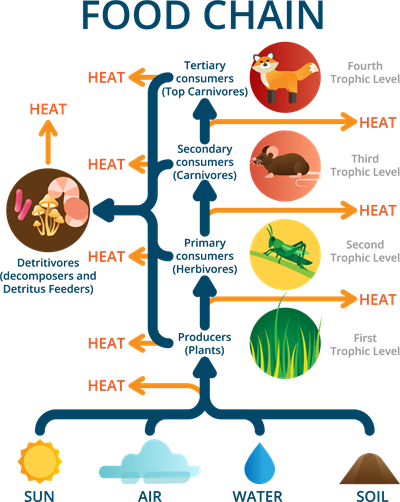
PUMPA - SMART LEARNING
எங்கள் ஆசிரியர்களுடன் 1-ஆன்-1 ஆலோசனை நேரத்தைப் பெறுங்கள். டாப்பர் ஆவதற்கு நாங்கள் பயிற்சி அளிப்போம்
Book Free DemoThe food chain starts with the energy provided by the sun. The sun is the ultimate source of energy, which is transformed into various sources of energy. When light energy from the sun falls on the leaves of plants, a portion of the solar energy is transformed into chemical energy through photosynthesis.

Process of photosynthesis
The chemical energy is stored in the form of substances like carbohydrates, starch, etc. This energy is the primary energy that supports the life forms and the activities of the living world.

The flow of energy
Important!
Energy obtained from the sun is stored in various parts of plants.
The herbivores consume plants, which convert chemical energy into kinetic energy in the form of doing work. In this process, there is also a dissipation of energy. When the herbivores are in turn consumed by the carnivores, further dissipation of energy occurs. In this way, an ecosystem's energy flow is established. The flow of energy can thus be described through food chains and ecological pyramids.

The transfer of energy
The flow of energy between various components of ecosystems has been studied extensively, and the following has been discovered:
- In a terrestrial ecosystem, green plants capture roughly 1 \% of the sunlight's energy that falls on their leaves to transform them into food.
- When primary consumers eat green plants, much energy is lost to the environment as heat. A part of energy goes into digestion and work, and the remainder goes into growth and reproduction. Roughly around 10 \% of the food consumed is converted into its own body and made available to the next level of consumers.
- As a result, 10 \% can be used as an average value for the quantity of organic matter present at each step before it reaches the next level of consumers.
- As very little energy is available for the next level of consumers, food chains usually consist of three or four levels. After four trophic levels, the energy loss is so high that very little usable energy is left.
- The lower trophic levels of an ecosystem have a higher number of individuals, with the producers having the highest number.
- Food chains vary tremendously in length and complexity. In general, each organism is eaten by two or more other organisms consumed by several others. Thus, the relationship can be depicted as a food web, a network of branching lines instead of a straight line food chain.
- The energy flow in a food chain is unidirectional, i.e. energy captured by the autotrophs does not revert as solar energy. Also, the energy passed to the herbivores does not return to the autotrophs.
- When a level progresses, there is no longer energy available to the previous level.

The tropic levels and their energy transfer
In the next theory, we will study ecological pyramids and their types.
Reference:
https://commons.wikimedia.org/wiki/File:Photosynthesis_en.svg
https://www.shutterstock.com/image-vector/food-chain-vector-illustration-diagram-biological-1652015542
https://commons.wikimedia.org/wiki/File:Diagram_of_Trophic_Layers_%26_Energy_Transfer_in_an_Ecosystem.svg